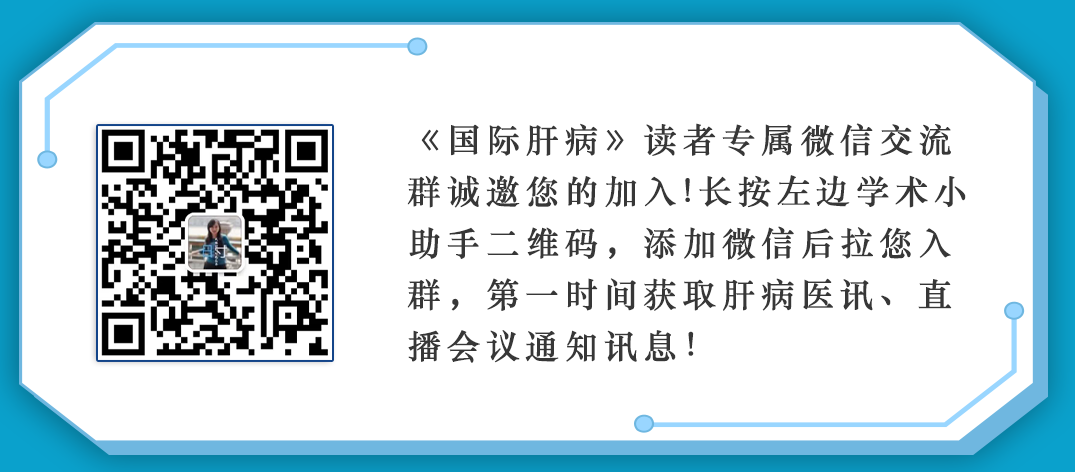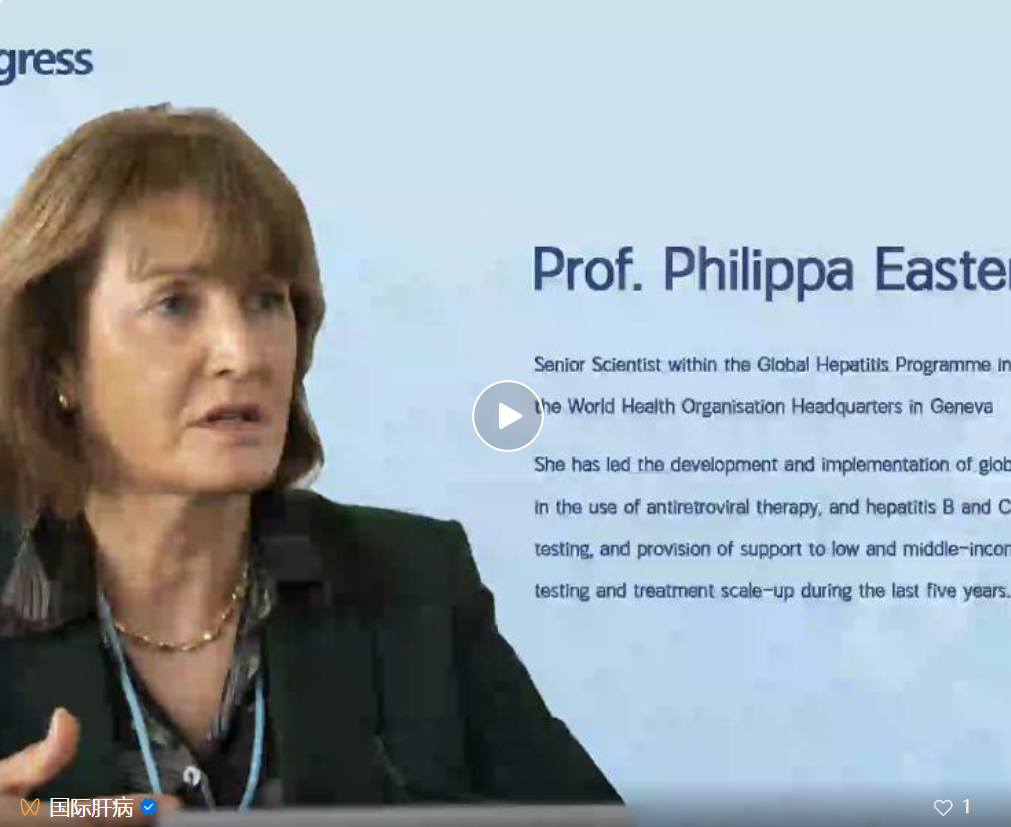当前位置:EASL-欧洲肝脏研究协会年会 » 正文
EASL专访丨WHO将出台新版乙型肝炎指南,重点扩大治疗适应证,简化诊疗路径
—— 作者: 时间:2023-07-02 01:39:19 阅读数:
44

第58届欧洲肝脏研究学会年会(EASL2023)暨2023年EASL大会(EASL Congress 2023)上,世界卫生组织(WHO)日内瓦总部艾滋病毒部门全球肝炎计划高级科学家Philippa Easterbrook教授出席WHO-ECDC联合论坛,介绍了正在编写中的WHO新版乙型肝炎指南关于扩大简化治疗标准、服务提供和诊断创新的新方向。《国际肝病》有幸邀请到Philippa Easterbrook教授就WHO 2030目标及各国消除肝炎进程、WHO乙型肝炎新版指南的编写进展和重要信息,全球如何把握乙型肝炎防治的机遇和挑战,进行了专访。
《国际肝病》
乙型肝炎是全球重要公共健康问题。WHO提出了至2030年消除病毒性肝炎危害的目标。对于这一目标,从目前统计数据看,各国进展如何?
Philippa Easterbrook教授:先了解一些背景信息有助于理解WHO肝炎消除策略的重要性。2016年,WHO首次发布了全球消除策略,旨在到2030年消除乙型和丙型病毒性肝炎公共卫生危害。消除的目标是新感染发病率减少90%和死亡率减少65%。在2021年,我们发布了一项以2030年为期的新消除策略,这次策略首次将艾滋病、病毒性肝炎和性传播感染/疾病(STIs)纳入其中。同年,我们为各国发布了关于如何证明已实现消除病毒性肝炎危害目标的指南。
我们提供的指导是,国家需要设定关于死亡率和新发感染率的目标,以及关于免疫、检测和治疗的项目目标。最重要的是,我们设定了阈值,即绝对目标,低于该阈值将证明该国已经实现了消除。其中一个衡量减少传播的指标是5岁以下儿童乙型肝炎表面抗原阳性的比例低于0.1%。此外,则需要证明感染者的确诊率超过90%,符合治疗条件的患者中80%接受了治疗,并且超过90%的人在婴儿期或者出生后接种了疫苗。
WHO每隔几年会更新各国的消除进展情况。我们首次基于2015年的数据进行了更新,而后基于2019年的数据,目前正在进行新一轮的数据更新。根据2019年的数据,对于乙型肝炎病毒(HBV)感染者的确诊率仅为10%。全球范围内,仅有2%的感染者接受了治疗。全球范围内的情况普遍不理想,尤其是在撒哈拉以南非洲地区。所以,我们还有很长的路要走。当前,各国正为实现2030目标努力,开展更多的检测和治疗,例如中国已开始进行大规模的诊疗。迄今为止,虽然全球进展缓慢,但消除的目标和明确的指导为各国提供了清晰的路径。
I think it's helpful to give a little bit of background from WHO as to the elimination strategy. So, the first ever global elimination strategy was launched in 2016 by WHO and that set out for the first time ambitious targets and plans for elimination by 2030, elimination of both viral hepatitis B and C as a public health threat. And that was defined as a 90% reduction in the incidence of new infections and a 65% reduction in mortality. In 2021, we launched a new strategy that takes us right up to 2030 and there are some changes. And for the first time, we've got a strategy now with HIV and hepatitis and STIs. So that was the strategy. And then in 2021, we launched for countries the first guidance on how countries can demonstrate that they've eliminated viral hepatitis. So, what do countries need to do to show they've eliminated?
And so, the guidance we came out with was for countries to have impact targets that's on mortality and new infections and then program targets that's covering immunization testing and treatment. And the big message here was that we set levels at thresholds, absolute targets below which it would demonstrate that the country had achieved elimination. So, it was less than 0.1% of children less than five years who were hepatitis B surface antigen positive. That was the measure for demonstrating reduction in transmission towards elimination. And then the other target was on death rates, you had to achieve less than 400,000. And then on the program targets, you had to demonstrate more than 90% of people with the infection had been diagnosed and 80% of those diagnosed and eligible had been treated and more than 90% had been vaccinated with the infant vaccination or birth dose.
And WHO has every few years an update on the progress how countries are moving towards meeting. We did that first in 2015, again based on 2019 data, and we are in the process of updating again. And the message from 2019 is, for hepatitis B, still only 10% of those infected have been diagnosed. And globally, only 2% overall of people with the infection had been treated. And right across globally it was pretty poor, but particularly sub-Saharan Africa. So, we've got a long way to go. But now countries are really stepping up with ambitious plans to test more, to treat more, and China is particularly starting to move to a large scale up. So, the progress to date has been slow, but with the goals of elimination and very clear guidance of what countries need to demonstrate, it's giving a very clear pathway now.
《国际肝病》
据悉WHO正在编写新版乙型肝炎指南。能否请您介绍新版指南的编写进展,以及预计提出的新建议或新方向?
Philippa Easterbrook教授:WHO的一个主要职责是制定适用于全球各地相关地区的规范性全球指南。在过去的八年里,WHO的全球肝炎项目已经发布了多个指南,包括2015年的乙型肝炎检测指南、2017年的乙型和丙型肝炎检测指南以及2022年的丙型肝炎指南。此外,我们还在2020年发布了关于使用抗病毒药物预防乙型肝炎母婴传播的指南。目前,我们仍在进行相关工作,且召开了有关乙型肝炎指南更新的首次主要会议。
首先,我想谈谈WHO指南的特点。与各国指南、美国肝病学会(ASLD)指南和欧洲肝脏研究学会(EASL)指南相比,WHO指南有三个重要区别。第一,WHO特别关注低收入和中等收入国家,出版指南的目标受众不仅包括医生和临床医师,还包括卫生部门的项目负责人,即那些在政府中主持肝炎防治项目的负责人。第二,我们的指南采用公共卫生方法,即采用简单标准化的药物方案作为首选方案。而EASL指南或AASLD指南则提供了针对高收入地区的多种个体化治疗方案。第三,我们采用GRADE方法,不仅考虑医学证据,还考虑了特定建议的利弊、项目可行性、患者或医护人员对特定建议的可接受性和偏好,以及资源利用。
在新版乙型肝炎指南中,我们明确了几个重要主题,并围绕这些主题提出了问题。相关主题包括扩大治疗的适应证、病毒载量阈值,以及针对HBsAg阳性妇女,如果她们无法获得HBV DNA检测,是否应该使用抗病毒药物预防措施。我们还在讨论是否应该在我们已经推荐的替诺福韦和恩替卡韦基础上,推荐使用丙酚替诺福韦(TAF)方案。我们正在研究采用床旁病毒载量检测、反射病毒载量检测(reflex viral load testing)以及检测乙型肝炎伴丁型肝炎的简化诊断路径。这对于促进对乙型肝炎伴丁型肝炎的检测非常重要。最后,我们也在思考如何简化医疗服务的提供。
我们在五月份进行了会议,并在六月份进行了跟进会议,计划在十月份发布指南。主要的信息是我们正在扩大治疗的适应证,更多的HBsAg阳性患者将可以接受治疗。我们提供了四种不同的治疗选择来满足治疗适应证的要求,其中三种无需进行病毒载量检测。我们也考虑到撒哈拉以南非洲地区在病毒载量检测方面的限制,所以需要考虑如何使患者接受治疗的途径更便捷。我们尤为强调良好的医疗服务供给。
数据显示,我们发现很多诊所没有对患者进行监测来确保他们按时服药并监测病毒载量以确保病毒载量得到控制。因此,我们将大力倡导提供良好的依从性支持,跟踪患者,确保他们不会在随访中失联。此外,将有更多的人可以接受治疗,这意味着更多的育龄妇女能得到治疗,将有助于预防儿童传播。
One of the major functions of WHO is to produce normative global guidelines covering all regions that are relevant to all regions globally. And over the last eight years that the global hepatitis program has existed at who, we've done guidelines early on 2015 in hepatitis B, on testing for hepatitis B and C in 2017. We have had now four guidelines for hepatitis C. The last one was in 2022. And then we've had guidelines in 2020 on the use of antiviral prophylaxis to prevent mother to child transmission of hepatitis B. So, we do a lot of guidelines. And now we are moving forward and have had the first meeting, the main meeting for the update of the hepatitis B guidelines.
I think one first thing to say is what's different about a WHO guideline? Because there are national guidelines, there are AASLD guidelines , there are EASL guidelines. And the main difference with the WHO guidelines is firstly, we particularly focus on low and middle income countries. And the target audience for our guidelines is not just doctors and clinicians, but it is the program managers in ministries of health, those who are at the government level organizing hepatitis programs. And another big difference is that our guidelines adopt the public health approach, that's simple standardized drug regimens, preferred regimens, whereas EASL guidelines, or AASLD guidelines are very individualized treatment for high income settings with a lot of treatment options. And then finally we adopt a methodology called the GRADE methodology. So, it's not just about the evidence. We also look at the balance of the benefits and harms about a particular recommendation, what the programmatic feasibility is, what the acceptability and preferences of patients or healthcare workers for a particular recommendation, what the resource implications are.
So now, moving on to the actual new hep B guidelines. So we started out by defining what are the topics, what are the really important topics and questions. So the first is on expanding treatment eligibility, the viral load threshold, the April score for determining fibrosis using antiviral prophylaxis potentially for all hep B surface standard and positive women if they can't get access to a hep B DNA. We also looked at whether we should have TAF, the pro drug of Tenofovir dual regimens, in addition to the Tenofovir and Entecavir we already recommend. We were looking at simplified diagnostic pathways using point of care viral load testing, using reflex viral load testing and testing for Delta (co-infection). Really, that was a big part on how we can promote testing for Delta co-infection and then finally about service delivery, how we can simplify.
So, I think some of the main messages we had the meeting in May, follow up meeting in June, we're planning to launch the guidelines in October. And the main messages are we're expanding the eligibility that a much higher proportion of those who have been suffering antigen positive will be eligible. There are four different options for meeting the treatment eligibility and so three of those four you don't need to have a viral load. So, because we are also catering for Sub-Saharan Africa where they have very limited access to the viral load assays, it's really important to factor in how to make treatment eligibility more accessible. And I think we are also putting a big emphasis on good service delivery.
We've seen from the data that a lot of clinics aren't necessarily monitoring patients for adherence, making sure they're taking their medication, monitoring their viral load to make sure it's suppressed. So, we're really going to be promoting the need to have good adherence, support, good tracking of people so they don't get lost to follow up and are kept in care. And these will be important messages coming out. But many more people will be eligible and it means many more women of reproductive age will be on treatment that weren't on treatment before and that will help prevent child transmission.
《国际肝病》
从全球视角看,当前乙型肝炎防治面临哪些挑战和机遇?您认为各国如何应对挑战和把握机遇?
Philippa Easterbrook教授:我认为与艾滋病或以前的丙型肝炎相比,乙型肝炎防治具有两个主要的机遇和优势。首先,我们有高效且低成本的乙型肝炎疫苗,这是20世纪公共卫生的巨大成功之一,而艾滋病和丙型肝炎尚无有效的疫苗可用。这是一个重要的优势,能够预防许多新的感染,中国在实施这种高效的疫苗干预方面非常成功。其次,是乙型肝炎的治疗。替诺福韦是一种高效、低成本且易于获取的药物,也可用于艾滋病的治疗。目前乙型肝炎治疗药物在全球范围内都易于获取且治疗成本低至每年30美元。这两个优势对乙型肝炎的管理非常重要。
然而,乙型肝炎和丙型肝炎的防治在全球也面临着一些挑战。首先是缺乏全球资助机构。与艾滋病相比,艾滋病有抗击艾滋病全球基金(Global Fund)或PEPFAR的支持,而乙型肝炎和丙型肝炎都没有类似的全球资助机构。这意味着各国政府和国家的项目需要自掏腰包来应对这一挑战。对于那些受肝炎影响最严重的国家,例如撒哈拉以南非洲地区,政府面临许多其他竞争性优先事项和有限资源,这增加了挑战的复杂性。
另一个挑战是乙型肝炎和丙型肝炎缺乏系统性的检测和病例发现方法。此外,缺乏社区意识也是一个挑战。例如,在撒哈拉以南非洲地区,社区普遍知晓艾滋病,对于乙型肝炎却知之甚少。尽管非洲乙型肝炎患者的数量超过了艾滋病患者,但乙型肝炎的知识普及度低。这种缺乏意识导致人们对这种疾病感到困惑和不确定,因此不愿接受检测。并且即使在接受治疗后,患者也经常中断治疗,因为他们对疾病缺乏了解。医疗工作者也面临着类似的问题,缺乏意识、对疾病的认知和对治疗的信心,以及培训不足。
至于今后的关键机遇,我认为主要存在于撒哈拉以南非洲地区和亚洲的某些地区,就是利用现有的艾滋病基础设施。这些基础设施包括诊所、人员、实验室、药物供应和药房。尽管并非所有国家都拥有完善的基础设施,但与艾滋病基础设施建立联系并加以利用能够起到很大的支持作用。许多乙型肝炎患者需要接受相同的药物治疗,例如替诺福韦,他们需要依从性支持,与艾滋病一样,需要进行实验室监测以确保病毒载量得到抑制。因此,我认为这是一个尚未完全利用的机会。
此外,我认为COVID-19带来了其他机遇。从COVID-19中我们学到的一件事就是远程医疗的可行性。中国在这方面取得了很大进展,通过电话咨询提供支持、依从性支持和疾病教育,为患者提供额外的支持。此外,COVID-19也使我们认识到自我检测的可能性,并且有越来越多的实验室扩大了分子检测的能力,自我检测在非洲也较为常见。床旁病毒载量检测仪器变得更加易于获取,这种仪器同样适用于乙型肝炎的检测。因此,我认为我们应该借鉴这些经验,并且COVID-19向我们展示了可以在短时间内检测大量人群的可能性。中国曾经进行了许多社区城市的检测,埃及在丙型肝炎方面也取得了成功,他们在6个月内成功对6700万人进行了检测。这些例子向我们展示了检测和发现病例的可行性,并且能够将患者与治疗联系起来。
总之,乙型肝炎和丙型肝炎面临着挑战,但也存在机会。利用已有的成功经验,加强社区意识和教育,借鉴COVID-19的远程医疗和检测经验,以及与艾滋病基础设施建立联系,这些都是下一步关键机遇。通过充分利用这些机会,我们可以更好地管理和控制乙型肝炎。
I think the two main opportunities and advantages that hepatitis B has compared to HIV or what was the case with hepatitis C, is we have a vaccine, we have a highly effective low cost vaccine that is really one of the great public health successes of the last century, really that it's a very effective tool. HIV doesn't have a vaccine, hepatitis C doesn't have a vaccine. So that's one big advantage. We can prevent a lot of new infections and China has been highly effective in implementing that very effective vaccine intervention. I think the second positive thing is that the treatment for hepatitis B is a very effective and low cost and widely available drug Tenofovir that's used also in HIV as part of the HIV regimens. And so it is available globally and the cost can be as low as $30 per year. So those are two big advantages.
One of the real challenges globally for hepatitis B is the lack of a global funder. So compared to HIV, that had or has, the Global Fund or PEPFAR, the US agency that funds a lot of the HIV programs in Sub-Saharan Africa. So for hepatitis both B and C, there is no global funder. So that means governments and national programs need to find domestic funding. And for many of the most affected countries, particularly in sub–Saharan Africa, those governments have many other competing priorities and limited resources. So I think that is a big challenge.
The second challenge I see is the lack of systematic approach to testing and case finding. And then I think the third challenge has been often the lack of political commitment. Having political commitment is so important in any public health response. And I think that's also partly linked to another challenge, which is lack of community awareness. So if you in Sub-Saharan Africa, for example, asking communities, they all know about HIV, but they don't know about hepatitis B, even though there are many more people with hepatitis B in Africa than there are with HIV, it hasn't had the visibility. People are confused, unaware, uncertain, and so they don't come for testing. And even when put on treatment, they often discontinue because they're not really aware. And I think that also applies to healthcare workers. There's a lack of awareness, understanding, and people are not confident about treating, there's not been enough training.
So to your last part about what are sort of the key opportunities now moving forward, I do think an opportunity, again, perhaps this is more for sub Saharan Africa, but applies to some regions in Asia is there is a lot of HIV infrastructure around. There are clinics, there are staff, there are laboratories, there's drug supply, there's pharmacies. That in some countries, not all countries. There is a real value in using and linking with the HIV infrastructure because a lot of the patients need the same it's a similar drug, the Tenofovir regimen. They need adherence support. Just as with HIV, they need the lab monitoring to make sure their viral load is suppressed. So I think that is an opportunity that's not probably being fully taken advantage of.
And then I think the other opportunities come out of COVID that one of the things we learned from COVID is telehealth, and I know that's been done very well in China also is doing consultations by phone, doing support, adherence support, educational sort of awareness can be done easily online to provide that additional support. And I think also with COVID we learned about self-testing and there were many more laboratories that expanded capacity with molecular testing and that happened a lot in Africa. These point of care viral load instruments were made even more widely available, which can be used for hepatitis B. So I think we need to build on that, and also COVID showed us that you can test large numbers of people in a very short space of time. That happened in China where large community cities had testing, and for hepatitis C in Egypt, we learnt from there that they managed to test 67 million people in the space of six months. So it's showing us it's possible, it's feasible to test and case find and then being able to link them to treatment.

声明:本文仅供医疗卫生专业人士了解最新医药资讯参考使用,不代表本平台观点。该信息不能以任何方式取代专业的医疗指导,也不应被视为诊疗建议,如果该信息被用于资讯以外的目的,本站及作者不承担相关责任。
标签:
访谈
专家访谈
乙肝
发表评论
全部评论
